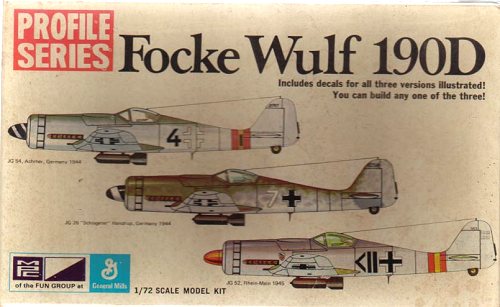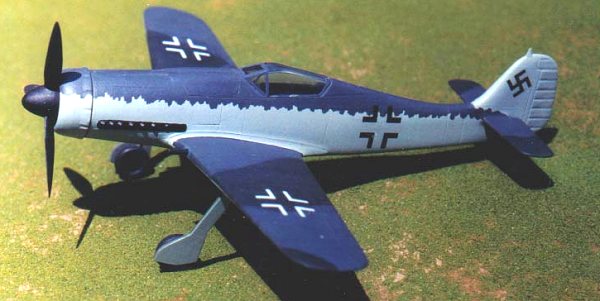
MPC/Airfix 1/72 Fw-190D-9
|
KIT: |
MPC/Airfix 1/72 Fw-190D-9 |
|
KIT # |
2-11091 |
|
PRICE: |
$1.00, in the mid-1970s |
|
DECALS: |
Three aircraft |
|
REVIEW & |
Steve Mesner |
|
NOTES: |
Mini-review` |

|
THE KIT |

The FW 190D, generally considered to be the Luftwaffe’s best
all-around fighter, has been a favorite modeling subject for years. This kit
must have been one of the first ever made of the subject, if not the very first.
It’s a poor kit, even by ‘60s Airfix standards. The shape is there, sort of. It
makes you think that the kit designer worked from a couple of poor-quality
oblique photographs, rather than from good scale drawings or actual measurements
or any sort of data of that kind. The surface detailing is raised panel lines,
with (the clue to its age) even thicker raised lines delineating the control
surfaces. Even Airfix got away from that horrible scheme many, many years ago!
Parts fit is casual, which is to say, bring your files, sandpapers, and putty.
“Detailing” is crude by any standards. The landing gear struts are molded right
into the gear doors, which aren’t particularly accurately shaped. The prop
blades are too small and misshapen, and the same can be said of the prop
spinner. The framing lines on the flat-sided (unblown) canopy are wrong, and
there’s nothing to speak of under that canopy. Wheel well detail? You must be
joking!
Back in the early ‘70s, MPC (Model Products Corporation), well known for their
1/25 American car kits, entered into a joint venture with Airfix to market the
latter’s 1/72 airplane kits in the US. For their first try, they marketed some
kits with “customizing” features--a chrome-plated sprue of generic
parts--exhausts, bombs, props, etc. Into these boxes also went sheets of
psychedelic decals (along with more ordinary military fare). These kits must
have flopped with both car and airplane modelers, as they weren’t on the market
long.
For their next try, MPC marketed the Airfix kits as the “Profile Series.” Each
kit featured decals for three different airplanes, which I believe were taken
from the color illustrations in Profile Publications. Full-color profiles
appeared as the box art. These are somewhat collectible today. In fact, in some
cases (such as the kit in question), the box and the
decals probably have more actual collector value than the kit itself.
|
CONSTRUCTION |
The kit I built was one of these, from the “Profile Series,”
bought sometime in the early or mid-’70s. If I hadn’t already started it way
back when, I’d have left it unbuilt just to see if it ever became valuable. But
I had started it, and a couple years ago, I ran across it again, right in the
middle of one of my infrequent fits of industry. You know how it is: Every now
and then you just have to grab some horrible wretched old kit and wrestle it to
the ground, just to prove to yourself and the world that you CAN do it!
After gluing the major subassemblies (fuselage, wings) together, I sanded
everything smooth with 320 and then 400 sandpaper. I rescribed the control
surfaces and some of the major panel lines. This proved the only bright point in
working on this kit: The lovely, virgin, pre-energy-crisis white styrene (so
familiar to ‘60s model car builders) was an absolute delight to work with! When
I finally had the airframe sanded and scribed into submission, it seemed almost
a shame to paint it!
I sanded and polished off the windscreen/canopy framing, and painted it back on
more accurately with a brush. Most of the canopy framework is molded as part of
the fuselage, by the way.
|
PAINT & DECALS |
Despite my best reworking efforts, when it came time to paint, I realized that
the thing still wasn’t ever going to be a quality-looking model, so I didn’t
want to waste any more effort than necessary on the paint scheme. Therefore I
selected as my subject Werk No. 210051, an early production airplane in an
often-reproduced photo, which had the flat canopy and
little if any mottling on the fuselage and fin. I hand-brushed the model with
Model Master II RLM 76, and used MM Gunship Gray 36118 and Euro I Gray 36081 for
the two uppersurface grays. (Hand-brushing is actually fun on white plastic!)
I didn’t use the kit “Profile” decals for a couple of reasons. They were by this
time more than 25 years old, yellowing a bit, and likely to crack. Worse yet,
they had a certain amount of built-in distortion, as if the decal paper had
moved or slid while going through a printing press. I ended up using generic
crosses and swastikas from old MicroScale sheets.
|
CONCLUSIONS |
The finished model looks “sort of” like a FW 190D from across the room, but
there are clearly better kits on the market. I’m no Luftwaffe kit expert, but
even I know that the venerable old Hasegawa 190D from the mid-70s is a much
better starting point for an accurate model. Is the Airfix the worst 1/72 scale
FW 190D kit around? Well, it’s fighting for the title with the one from
Lindberg, which is bad in a whole different set of ways...but that’s another
story....
Sorry, gang, there’s just not much in the Airfix FW 190D to like. I had fun
seeing how far I could get with mine, and am even almost halfway proud of what I
was able to accomplish, but I could have built three better models in the time I
spent with it, and I have no desire to ever build another one. If you have a
mint, unbuilt one in an old original Airfix box, or the MPC “Profile” issue, you
might want to see what it would bring on the collector or eBay market.
Otherwise, it might make a good kit for a youngster who’s not too deeply into
accuracy or detailing.
Model on!
If you would like your product reviewed fairly and quickly by a site that averages thousands of visits a day, please contact me or see other details in the Note to Contributors.